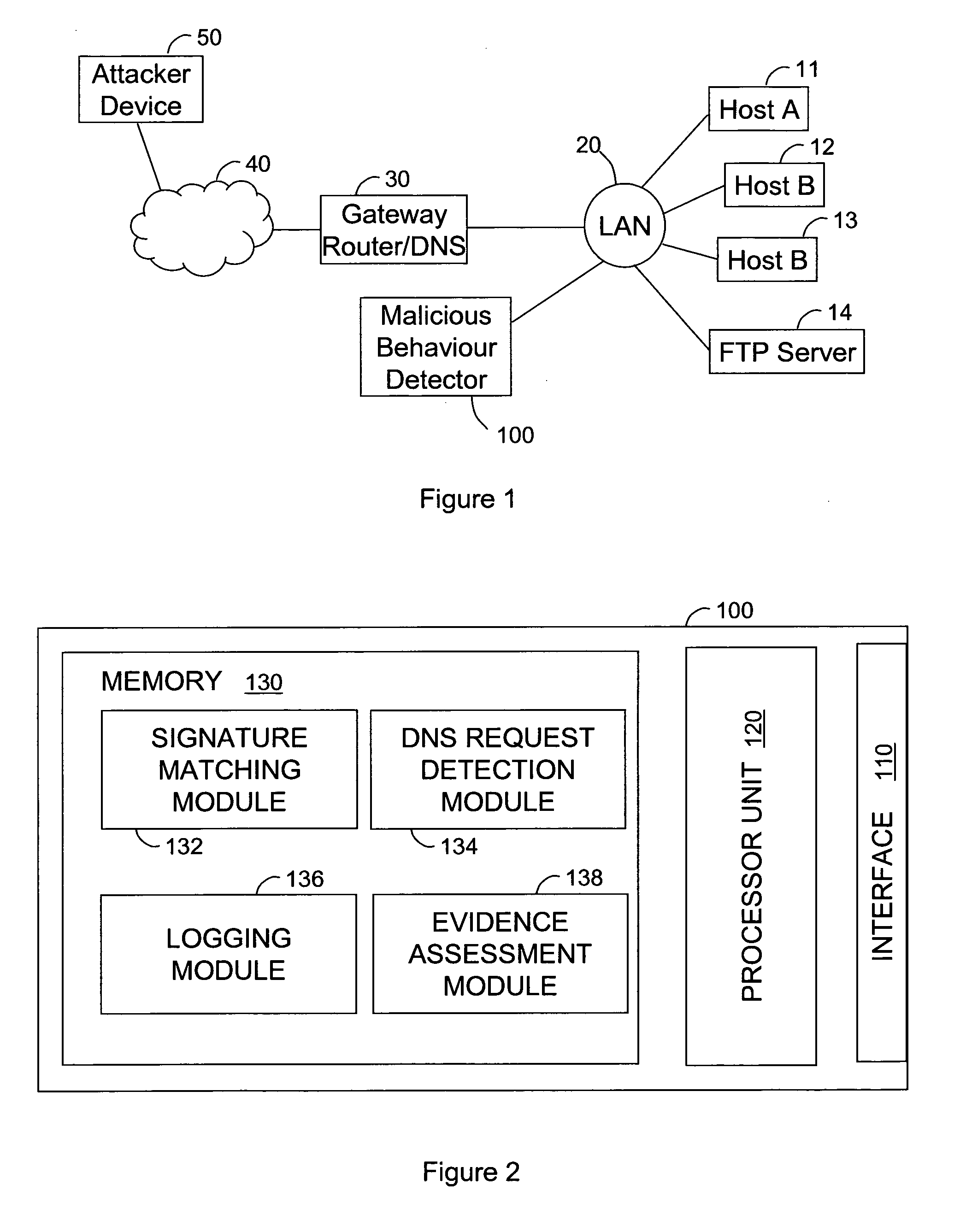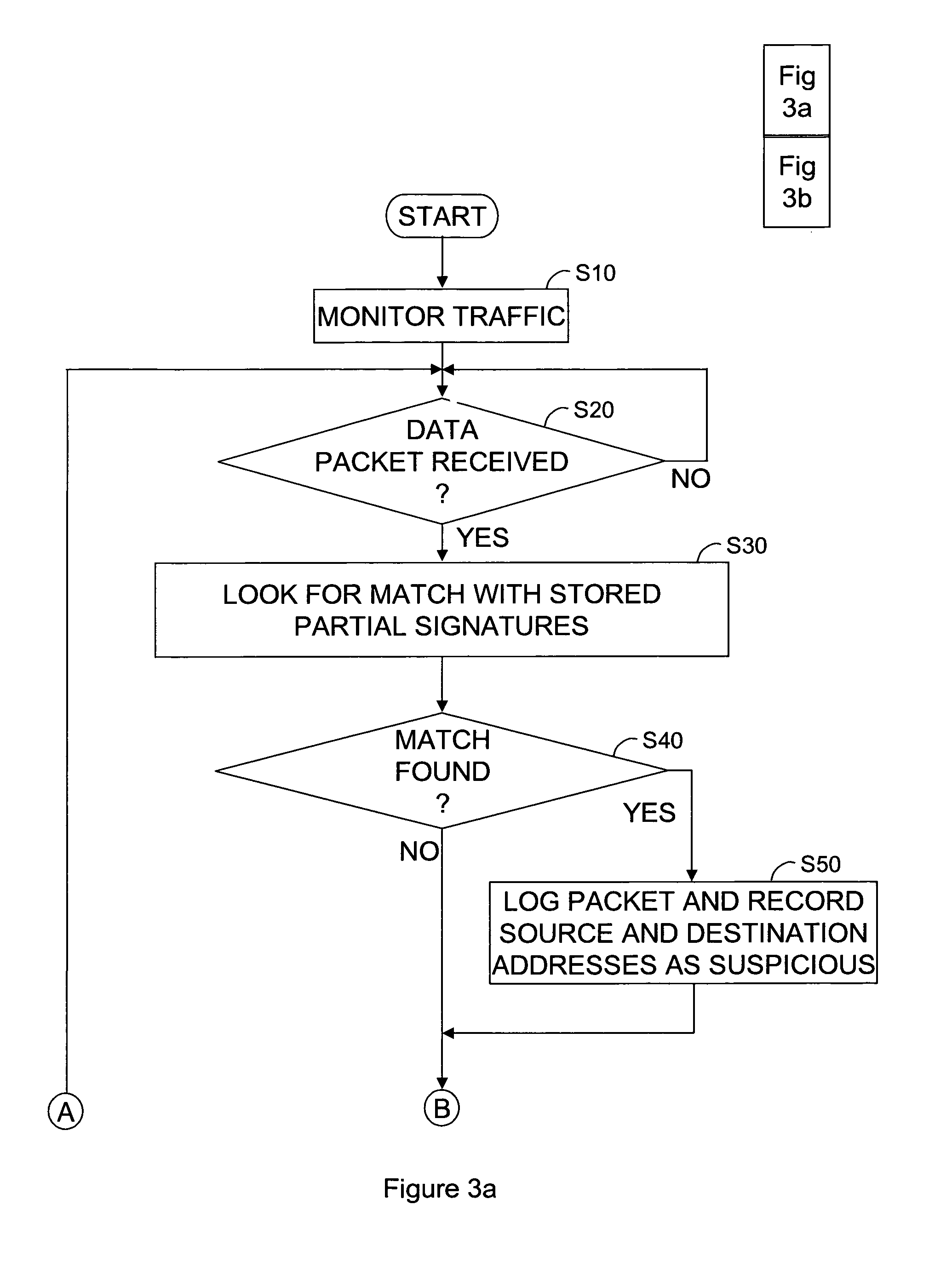[0012]Looking for only a part of a virus signature can be advantageous because it may be possible to find a key part of the virus that is common to all related variants of a particular virus strain, and even of all forms of metamorphosing viruses. Furthermore, and of special benefit in the present invention, if a key part can be found which is less than a common packet size of packets travelling through the network, it may be possible to look for such partial signatures on a packet by packet basis rather than having to maintain information about entire flows of data etc as might otherwise be required to perform signature detection within a network rather than on a host device.
[0013]Of course, the disadvantage of using such a small portion only of a virus for signature detection is that the method is much more likely to generate many false positives. This disadvantage is however mitigated in the present invention by the cooperative use of the DNS monitoring. By combining the evidence from both techniques many false positives can be ruled out, greatly reducing the total number of false positives generated by the method. Furthermore, DNS request monitoring is well suited to being carried out within a network and so the method as a whole may conveniently be carried out within a network, which has significant benefits over host based methods (e.g. e.g. the network administrator need not rely on the diligence of the host user in keeping anti-virus software up-to-date, the burden on individual host users is reduced, the networks broader perspective on the overall behaviour of the network as a whole can be leveraged, etc.).
[0016]The invention provides significant benefits over known systems such as described in US 2004 / 123141 which look for entire signatures (e.g. entire sections of malicious code) because the vulnerable memory location or number of memory locations within a given range of memory locations are relatively static and cannot be obfuscated (e.g. by encryption or code morphing) if the attack is to work. Therefore the present invention is able to detect even sophisticated rapidly morphing polymorphic viruses as well as zero day attacks (i.e. before a virus has been recognised and it's signature identified).
[0018]It has recently been established that on certain operating systems (e.g. various versions of the Windows™ Operating Systems produced by Microsoft Corporation) certain system programs (e.g. Dynamic Link Libraries (DLL's)) are always loaded into the same memory address of a system's memory when executed. This fact can be exploited by malicious users seeking to infect a victim computer. A particularly common way of using this information currently is in developing a buffer overflow exploit. In such an exploit, knowledge of the memory location at which a particular system program (which is known to be used by a particular known application—e.g. a File Transfer Protocol (FTP) server application) is loaded into the system memory can be used to improve the chance of a malicious piece of code being successfully run without detection by the victim host.
[0019]An analysis of a number of polymorphic / metamorphic worms using such tactics performed by the present inventors has shown that in general although the actual program run by the worm (in particular the shell code portion) may vary considerably, in order for the exploit to work correctly, the worm needs to include the memory location associated with the target system program (e.g. a DLL) in the clear (i.e. in non-obfuscated form, where obfuscation means, of course, any sort of obscuring including encryption). This therefore represents an excellent mini-signature of a piece of malicious code. Of course, since a system memory location is normally expressed as a fairly short binary number (e.g. a 32 bit number) there is a significant risk of a particular series of bytes matching a known vulnerable memory location entirely by accident. However, this risk is still relatively small (e.g. finding the binary representation of any one of up to 1000 identified memory locations by chance should have a probability of less than 0.00001 percent for a random binary sequence) and can be reduced by simple measures such as looking for adjacent byte symbols that normally have to accompany the memory location in the malicious code in order for it to be correctly interpreted, checking that the protocol being used for encoding the contents of the packet are correctly understood to avoid false detection based on obscure encodings, etc. Generally the more such corroborative checking as is done, the more costly in terms of processing resource required by the matching hardware performing the checking, but the lower the risk of getting accidental false positives etc. and the final balance selected is a matter of choice for a particular network given the size of the network and the available hardware for performing the checking etc.
[0020]Embodiments of the present invention provide a number of technical benefits in the field of detecting malicious behaviour. For example they can detect infections after only a single infection attempt, they can detect worms on day zero (i.e. as soon as a worm appears regardless of whether or not it has already been analysed by security experts. They can detect polymorphic worms. They can be made to have an arbitrarily low false positive rate, and they are relatively easy to implement in most network architectures.
 Login to view more
Login to view more  Login to view more
Login to view more 


